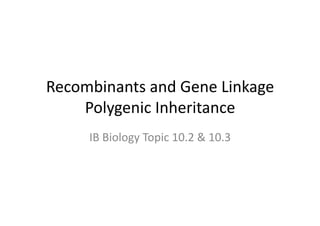
Recombination and gene linkage
- 1. Recombinants and Gene Linkage Polygenic Inheritance IB Biology Topic 10.2 & 10.3
- 2. Typical Dihybrid cross Two traits are considered-‐ • seed color (yellow vs. green) • seed texture (wrinkled vs. round) 9:3:3:1 phenotypic raDo when 2 dihybrid heterozygous parents are crossed.
- 4. Independent assortment An Interpretation from the Dihybrid cross • During gamete formation, segregating pairs of unit factors assort independently." • In other words, segregation of 2 alleles at one genetic locus has no effect on the segregation of 2 alleles at another locus." • For example, the assortment of yellow and green alleles has no effect on the assortment of round and wrinkled alleles, and vice versa." • Results have expected, typical ratios"
- 5. Discovery of Linkage • William Bateson and R.C. PunneP were working with several traits in sweet peas, • a gene for purple (P) vs. red (p) flowers • a gene for long pollen grains (L) vs. round pollen grains (l).
- 6. Bateson and Punnett pea study: Flower Color: P = purple p = red Pollen seed shape: L = long l = round True Breeding lines: PPLL x ppll PpLl F1 Phenotype Observed Expected Expected Ra5o Number Purple long 284 9 215 Purple round 21 3 71 Red long 21 3 71 Red round 55 1 24 Crosses produced a deviaDon from the predicted Mendelian independent assortment raDos. What is going on????
- 7. Results: There are 4 expected genotypes There are 4 recombinant genotypes but cannot be observed from phenotypes There are 2 recombinant phenotypes which would be actually observed during the experiment Results did not show a typical 9:3:3:1 therefore not dihybrid unlinked. Results did not show a totally linked raDo either (3:1) Therefore, there must be something else happening with the genes.
- 8. • Because the parental phenotypes reappeared more frequently than expected, the researchers hypothesized that there was a coupling, or connection, between the parental alleles for flower color and pollen grain shape • This coupling resulted in the observed deviation from independent assortment.
- 10. Thomas Morgan’s work with Drosophila lead to the discovery of linked genes and recombina5on due to crossing over • Morgan proposed that the chiasmata visible on chromosomes were regions of crossing over. • Occurs between non-‐sister chromaDds.
- 11. EvoluDon, Natural SelecDon and Crossing Over • From an evolutionary point of view, the purpose of sex is to re-shuffle the combinations of alleles so the offspring receive a different set of alleles than their parents had. • Natural selection then causes offspring with good combinations to survive and reproduce, while offspring with bad combinations don’t pass them on. • Genes are on chromosomes. Meiosis is a mechanism for re-shuffling the chromosomes: each gamete gets a mixture of paternal and maternal chromosomes. • However, chromosomes are long and contain many genes. To get individual genes re-shuffled, there needs to be a mechanism of recombining genes that are on the same chromosome. This mechanism is called “crossing over.
- 12. RecombinaDon due to crossing over
- 13. Recombinants RecombinaDon= the reassortment of alleles into combinaDons different from those of the parents, as a result of: independent assortment, crossing over and/or ferDlizaDon. Example-‐ recombinants due to crossing over Linked genes: A with B AB high frequency a with b ab high frequency Recombinant a with B aB low frequency Recombinant A with b Ab low frequency Recombinants due to crossing over will always have a lower frequency
- 14. Cross with 2 linked genes
- 15. Frequency of crossover exchange... of chroma5ds of a homologous pair at synapsis forming a chiasmata... • Frequency is GREATER the FARTHER apart 2 genes are is propor5onal to rela5ve distance between 2 linked genes Rela5ve distance is established as... • 1% crossover frequency = 1 map unit of map distance • 1% CrossOver Freq = 1 cen5Morgan (cM)
- 16. Genetic Map of Drosophila melanogaster"
- 18. • Polygenic inheritance-‐ more than one gene contributes to a phenotype. A characterisDc that is controlled by more than one gene. • Allows for conDnuous variaDon • Examples include: human height, human skin color, wheat seed color
- 19. Polygenic Traits – Skin Color About 5 genes are involved in human skin color which creates a conDnuous range of skin color in the populaDon from very light to very dark. Each gene has 2 melanin-‐producing alleles that are codominant. Therefore, many genes contribute to the color of skin EvoluDon has selected for greater melanin-‐ producDon in areas where there is more intense sunlight to protect against UV radiaDon and prevent skin cancer. Lower light intensity regions selected over Dme for less melanin to allow for more Vitamin D producDon SelecDve advantage of skin color is now compensated/overcome by the use of sunblock and vitamin D supplements. Using whitener on your skin is a terrible idea!